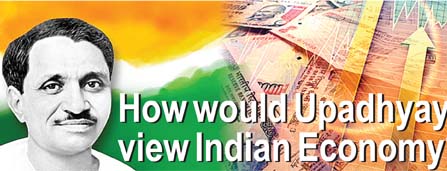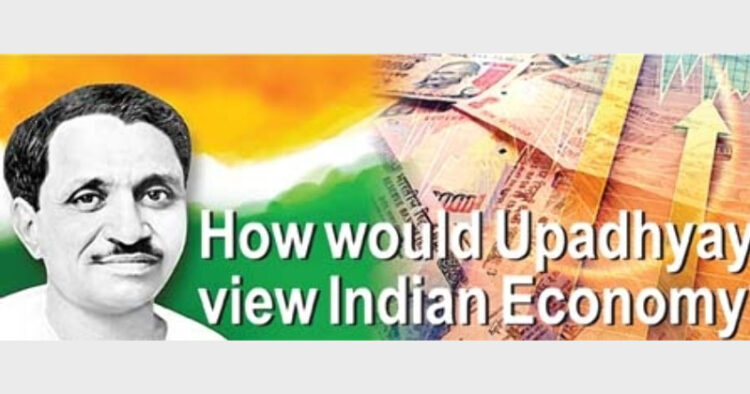 Intro: A strong votary of ‘economic democracy’, how would Deendayal Upadhyaya view Indian economic scenario, if he were to come back to life??
Intro: A strong votary of ‘economic democracy’, how would Deendayal Upadhyaya view Indian economic scenario, if he were to come back to life??
Deendayal Upadhyaya was a part of the Indian tradition of leaders like Dadabhai Naoroji, M G Ranade, Gopal Krishna Gokhale, Mahatma Gandhi and Ram Manohar Lohia who worked in politics and simultaneously kept an eye on the socio-economic conditions prevailing in the country. Apart from the Economic Resolutions he drafted for the Party Conventions and his numerous articles in the Organiser and Panchjanya on economic problems of the country, Upadhyaya authored three monographs on Indian economic issues, namely ‘Bhartiya Arthaniti: Vikas kee ek Disha’, ‘The Two Plans: Promises, Performance and Prospects’ and ‘Devaluation: A Great Fall’.
Let us take a look at how would Deendayal Upadhyaya view the Indian economy if he were to come back to life on his birth anniversary, September 25, 2014?
Undoubtedly happy over a former RSS pracharak taking over the reins of the country on a twin mandate of progress and Hindutva, Deendayalji would appreciate the 5.7 percent GDP growth in the first quarter of FY 2014-15 and marvel at the roughly 7 percent trend (or long-term) rate of growth of Gross Domestic Product (GDP) registered by the country in the last 15 years. In his lifetime, Upadhyaya did not have the satisfaction of seeing the Indian economy grow at more than 3 percent or so.
The quantum jump in the production of foodgrains to 260 plus million tonnes would also comfort him. He had witnessed the spectre of mass starvation haunting the Indian masses in the late fifties forcing the government to seek a foodgrains loan from USA then. On the PL-480 Agreement, he wrote in the Organiser on 16 May, 1960 “the US Ambassador has claimed that America is following the (PL-480) policy to assure the struggling people of the world-democracies that ‘freedom and food can go together’. But what we want is ‘our own freedom and our own food’ ….. We shall, therefore, warmly greet Patil( then Agriculture Minister) not on his return from America, but when he boosts our production to achieve self-sufficiency in foodgrains.”
He would be awestruck at the huge accretion of foreign exchange reserves. The nearly $ 320 billion of forex reserves would put him at ease. He had seen foreign exchange reserves dwindle to a dangerously low level leading to the devaluation of the rupee in 1966 and a scramble for support from the (International Monetary Fund) IMF, World Bank and Aid India Consortium. Suggesting an alternative path of indigenous resource mobilization then, he wrote “had we refused to devalue our rupee, maybe those giving us economic aid would have developed cold feet. But then, we should have decided to make our progress without foreign aid. This would have been economically profitable and politically honourable. It would have surely ensured a determined progress with revolutionary changes in our plans and policies.”
Notwithstanding the progress in the aforesaid traditional quantitative macroeconomic indicators, some of the key failures of India’s political economy would severely disappoint the activist and scholarly politician.
Economic reforms since 1991 have led to a capital intensive, energy intensive and import oriented growth pattern. Deendayalji had struck a note of caution against the lopsided nature of growth 50 years back. In an interview to the Organiser (April 13, 1964) he’d said “we have imported expensive machinery to build dams. I think we should have used more labour to build them. I find that Mysorean engineers, with their good experience on local projects, who worked on the Chambal project did that. I wish the same had been done on our other dams.” Similarly, disapproving the methods of construction of civil works going on nationwide then he said “We are building them all with cement. Why could we not use bricks, locally made? That would not only have reduced the pressure on railways to transport heavy cement but also encouraged local, decentralised brick-kiln industry.” Clearly, Deendayal Upadhyay would advocate a course correction in the pattern of growth.
Conventional economic wisdom tells us that investment expenditure steps up economic growth and augments aggregate supply or production but this process also simultaneously fuels an increase in aggregate demand or aggregate expenditure thereby leading to inflationary pressures in the economy. Therefore, if the conspicuous consumption expenditure can be reduced as the investment expenditure goes up, that is, if savings keep parity with investments; then the country could witness growth with price stability. In a speech on 28 June 1959, Upadhyaya had said “if we fail to promote the concept of restraints on consumption, the people would not be happy despite increasing supplies of commodities…..We must learn to live within limits. More capital would then not be needed to meet increasing consumption.” By emphasizing thrift, he would infact tackle the high growth-high inflation conundrum in the post-reforms era.
Deendayalji would be concerned about food inflation. Way back in 1964, he said “Government should subsidise food articles for those earning, say, less than Rs 200 per month. Government could easily find money for this by checking its expenditure on administration, which is consuming 20 percent of all government revenues.”
He would also use growth to combat poverty by advocating a change in our current ordering of investment priorities. Instead of merely focusing on increasing the overall GDP growth rate, he would suggest a rapid growth of the basic needs sector. Elucidating the Bharatiya Jan Sangh kee Arthneeti way back in 1954, he said “essential needs of roti, kapda, makaan, parhai aur dawai (Food, clothes, house, education and medicine) of everyone should be fulfilled.” Clearly, he would suggest greater investment in wage goods like foodgrains and clothing, construction of low cost dwellings for shelter, drugs and pharmaceuticals and public health centres for medical care, books, paper and building materials for schools and colleges, bicycles and buses for transport.
The paradox of widespread hunger amidst huge stocks of foodgrains would disturb Deendayalji. Dwelling upon the need to provide food security to the masses, he wrote in the Organiser(April 25,1960) “The only course is to set up a Central Corporation or some such statutory body which should take upon itself the entire responsibility of purchasing and selling foodgrains.” Undoubtedly, he would advocate an urgent and thorough revamp of the Public distribution System (PDS) in the country and universal coverage under it.
He would also suggest a vigorous pursuit of employment generating policies. In a piece entitled ‘Yojna Badlo’ for Panchjanya in 1965, he wrote “It is evident that we are not utilizing human resources optimally for the development of the country. The main drawback of the plans is that they are not labour-intensive.” Advocating for ‘Big Plan of small units’ Deendayal Upadhyaya had pushed for ‘the first priority in every plan’ for ‘work to every hand’. Certainly, in the present context, he would recommend a renewal of small scale and cottage industries and production of basic consumer goods to fight jobless growth.
Also Read This : Soaring NPA Levels and Indian BANKS
In July 1953, Upadhyaya had promised Jana Sangh’s commitment “to end the inequality in incomes and expenditures of different sections of the society. We want to establish a ratio of 1: 20 between the lowest and highest income.” The current process of large scale and centralised economic growth in the last two decades has led to greater availability of capital making capital cheap; the consequence being that production has become capital intensive and workers’ incomes have been declining leading to inequalities in income. In his inaugural address at the Jana Sangh Conference held at Pilani in 1955, he said “we shall have to understand that howsoever these economies (referring to American, Russian and other European economies) may differ in details, there is one basic similarity. All have accepted the machine as the means of economic development. And the machine has a universal characteristic– maximum production by little labour. We shall have to admit that the path of India’s economic development is not the path of mechanization.” To tackle it he would prescribe a process of decentralized economic development with small sized industrial units and small farms making intensive use of labour as the antidote to the income inequalities prevailing now.
Inequalities in expenditure have been accentuated by the current culture of vulgar consumption by the affluent sections of society. On the recommendations of the Nicholas Kaldor Commission appointed by Jawaharlal Nehru, Deendayal Upadhyaya wrote “I wish the Government accepts the whole scheme of Kaldor’s suggestions.” Prof Kaldor had then suggested a tax on expenditure. Today Upadhyaya would have definitely proposed the imposition of an expenditure tax on those who spend recklessely in order to curb the current expenditure inequalities.
What would be his economic vision for India’s future? His principal concern would be the economic plight of the downtrodden masses. Growth without Antyodaya would make little sense to him.
-C Rajashekhar ?(The writer is the All-India Convenor of the BJP’s Economic Cell)?













Comments